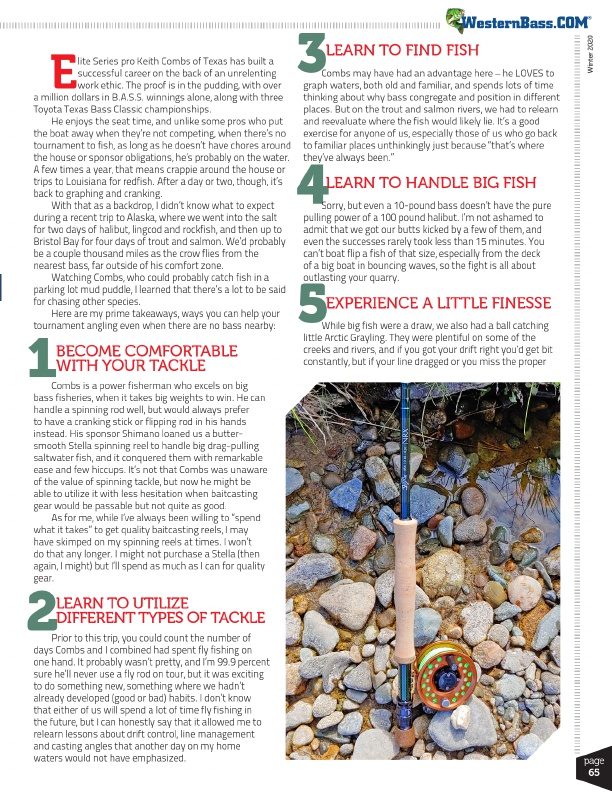
1 2 5 4 3 E
lite Series pro Keith Combs of Texas has built a
successful career on the back of an unrelenting
work ethic. The proof is in the pudding, with over a million dollars in B.A.S.S. winnings alone, along with three
Toyota Texas Bass Classic championships.
He enjoys the seat time, and unlike some pros who put
the boat away when they’re not competing, when there’s no
tournament to fish, as long as he doesn’t have chores around
the house or sponsor obligations, he’s probably on the water.
A few times a year, that means crappie around the house or
trips to Louisiana for redfish. After a day or two, though, it’s
back to graphing and cranking.
With that as a backdrop, I didn’t know what to expect
during a recent trip to Alaska, where we went into the salt
for two days of halibut, lingcod and rockfish, and then up to
Bristol Bay for four days of trout and salmon. We’d probably
be a couple thousand miles as the crow flies from the
nearest bass, far outside of his comfort zone.
Watching Combs, who could probably catch fish in a
parking lot mud puddle, I learned that there’s a lot to be said
for chasing other species.
Here are my prime takeaways, ways you can help your
tournament angling even when there are no bass nearby:
BECOME COMFORTABLE WITH YOUR TACKLE
Combs is a power fisherman who excels on big bass fisheries, when it takes big weights to win. He can handle a spinning rod well, but would always prefer to have a cranking stick or flipping rod in his hands instead. His sponsor Shimano loaned us a butter- smooth Stella spinning reel to handle big drag-pulling saltwater fish, and it conquered them with remarkable ease and few hiccups. It’s not that Combs was unaware of the value of spinning tackle, but now he might be able to utilize it with less hesitation when baitcasting gear would be passable but not quite as good.
As for me, while I’ve always been willing to “spend what it takes” to get quality baitcasting reels, I may have skimped on my spinning reels at times. I won’t do that any longer. I might not purchase a Stella (then again, I might) but I’ll spend as much as I can for quality gear.
LEARN TO FIND FISH
Combs may have had an advantage here – he LOVES to graph waters, both old and familiar, and spends lots of time thinking about why bass congregate and position in different places. But on the trout and salmon rivers, we had to relearn and reevaluate where the fish would likely lie. It’s a good exercise for anyone of us, especially those of us who go back to familiar places unthinkingly just because “that’s where they’ve always been.”
LEARN TO HANDLE BIG FISH
Sorry, but even a 10-pound bass doesn’t have the pure pulling power of a 100 pound halibut. I’m not ashamed to admit that we got our butts kicked by a few of them, and even the successes rarely took less than 15 minutes. You can’t boat flip a fish of that size, especially from the deck of a big boat in bouncing waves, so the fight is all about outlasting your quarry.
EXPERIENCE A LITTLE FINESSE
While big fish were a draw, we also had a ball catching little Arctic Grayling. They were plentiful on some of the creeks and rivers, and if you got your drift right you’d get bit constantly, but if your line dragged or you miss the proper
LEARN TO UTILIZE DIFFERENT TYPES OF TACKLE
Prior to this trip, you could count the number of days Combs and I combined had spent fly fishing on one hand. It probably wasn’t pretty, and I’m 99.9 percent sure he’ll never use a fly rod on tour, but it was exciting to do something new, something where we hadn’t already developed (good or bad) habits. I don’t know that either of us will spend a lot of time fly fishing in the future, but I can honestly say that it allowed me to relearn lessons about drift control, line management and casting angles that another day on my home waters would not have emphasized.
®
Winter 2020
page 65